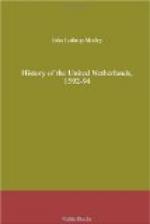On the 28th May, 1592, Maurice, taking the field with six thousand foot and two thousand horse, came once more before Steenwyck. It will be remembered that he had been obliged to relinquish the siege of this place in order to confront the Duke of Parma in July, 1591, at Nymegen.
The city—very important from its position, being the key to the province of Drenthe as well as one of the safeguards of Friesland—had been besieged in vain by Count Renneberg after his treasonable surrender of Groningen, of which he was governor, to the Spaniards, but had been subsequently surprised by Tassis. Since that time it had held for the king. Its fortifications were strong, and of the best description known at that day. Its regular garrison was sixteen companies of foot and some cavalry under Antoine de Quocqueville, military governor. Besides these troops were twelve hundred Walloon infantry, commanded by Lewis, youngest Count van den Berg, a brave lad of eighteen years, with whom were the lord of Waterdyck and other Netherland nobles.
To the military student the siege may possess importance as marking a transitional epoch in the history of the beleaguering science. To the general reader, as in most of the exploits of the young Poliorcetes, its details have but slender interest. Perhaps it was here that the spade first vindicated its dignity, and entitled itself to be classed as a military weapon of value along with pike and arquebus. It was here that the soldiers of Maurice, burrowing in the ground at ten stuyvers a day, were jeered at by the enemy from the battlements as boors and ditchers, who had forfeited their right to be considered soldiers—but jeered at for the last time.
From 30th May to 9th June the prince was occupied in throwing up earthworks on the low grounds in order to bring his guns into position. On the 13th June he began to batter with forty-five pieces, but effected little more than to demolish some of the breast-works. He threw hot shot into the town very diligently, too, but did small damage. The cannonading went on for nearly a week, but the practice was so very indifferent—notwithstanding the protection of the blessed Barbara and the tuition of the busmasters—that the besieged began to amuse themselves with these empty and monotonous salvos of the honourable Artillery Guild. When all this blazing and thundering had led to no better result than to convert a hundred thousand good Flemish florins into noise and smoke, the thrifty Netherlanders on both sides of the walls began to disparage the young general’s reputation. After all, they said, the Spaniards were right when they called artillery mere ‘espanta-vellacos’ or scare-cowards. This burrowing and bellowing must at last give place to the old-fashioned push of pike, and then it would be seen who the soldiers were. Observations like these were freely made under a flag of truce; for on the 19th June—notwithstanding their contempt for the ’espanta-vellacos’—the besieged had sent out a deputation to treat for an honourable surrender. Maurice entertained the negotiators hospitably in his own tent, but the terms suggested to him were inadmissible. Nothing came of the conference therefore but mutual criticisms, friendly enough, although sufficiently caustic.




